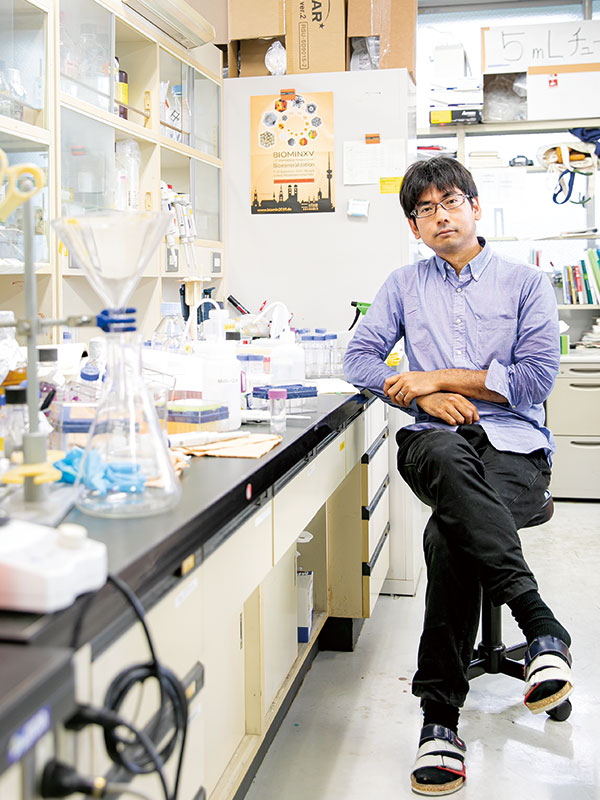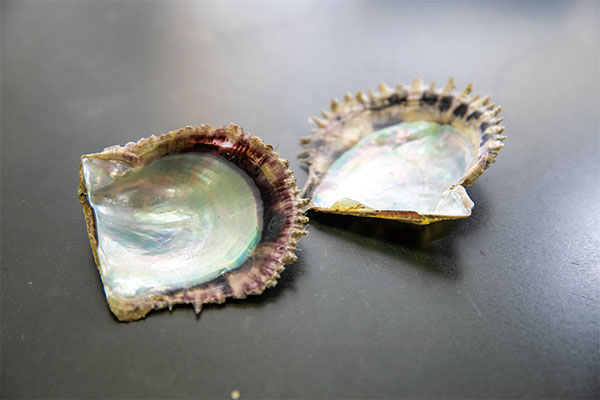Shining light on how pearls and other biominerals are formed Finding answers between biochemistry and mineral chemistry

UTokyo 30s
Up-and-coming young researchers
Of the approximately 5,800 faculty members active at the University of Tokyo, we have selected nine energetic young researchers in their 30s. In terms of their job titles, there is one professor, two associate professors, one project associate professor, one lecturer, one project lecturer and three research associates. What kind of research are they engaged in day to day? And what is their temperament like? Let’s find out.
| Biomineralization |
Shining light on how pearls and other biominerals are formed
Finding answers between biochemistry and mineral chemistry
 Michio Suzuki Michio SuzukiAssociate Professor, Graduate School of Agricultural and Life Sciences |

The process by which living organisms produce inorganic minerals is known as biomineralization, and the minerals produced by living organisms are called biominerals. Typical examples include pearls, shells, corallum (coral skeletons) and the exoskeletons of shrimp and crabs. In human beings, our bones, teeth, and stones that form in the urinary tract are similar examples. While these biominerals have extremely intricate structures and superlative material properties, it has not been clear how they are formed. Associate Professor Michio Suzuki has elucidated one aspect of this mechanism using the example of Akoya pearl oysters (Pinctada fucata), which are used in pearl aquaculture.
“Akoya pearl oyster shells can be divided up into a nacreous or mother-of-pearl layer that casts the same iridescent luster as the pearl, a prismatic layer outside that, and then the outer shell beyond that, along with the ligaments at the hinges. Chemical analysis of the intricate structure of the nacreous layer has revealed that a key role is played by a novel matrix protein known as Pif. That is, Pif interacts with the calcium carbonate crystals to control the nacre formation.”
This analysis would have been impossible to attempt without an understanding of both organic and inorganic matter. While these two tend to be conceptualized separately in the world of chemistry, for Suzuki, who specialized in biochemistry at the Graduate School of Agricultural and Life Sciences and mastered methods for analyzing inorganic minerals at the Graduate School of Science and in overseas laboratories, it was only natural to consider both.
“The year I spent at the Weizmann Institute of Science, a hub for the world’s top biomineral researchers in Israel, was inspiring. I was a postdoc when I returned to Japan, where I married one of my younger colleagues at the laboratory. At the time, I was living on one-year appointments, so I felt that I would never be able to get married if I waited for my career to stabilize.”
Suzuki says that with the elucidation of the mechanisms of biomineral production, “the players are finally ready to go.” Many unclear molecular mechanisms yet remain, and he is now at a stage where he can begin to proceed with full-scale research. If the whole mechanism can be understood, it will be possible to improve the efficiency of pearl farming, which currently entails significant waste. And we cannot overlook the soil improvement effects and antibacterial properties of the oyster shells. Moreover, the shells – which contain a lot of calcium carbonate – play a role in fixing atmospheric CO2, which could potentially contribute to the prevention of global warming.
“Of course, I'm not necessarily doing research with the idea of helping in any one thing in particular. For me, ideally, the results of my devotion to basic research will lead to the creation of things that will be widely used in society.”
Once, Suzuki would spend most of his waking moments on experiments, but these days he enjoys playing with his three children in the park. Seven years ago, as one might expect, he chose a Mikimoto pearl for his wife’s engagement ring.
| Q & A | |
|---|---|
| What kind of work did you dream of doing as a child? | “I love sea creatures, and in elementary school I wanted to work in an aquarium.” |
| What extracurricular activities were you involved in as an undergraduate? | “Things like the mountaineering club, the biology club, swimming and Gundams (giant robots featured in a popular anime series).” |
| What are your hopes for your children? | “I want them to live freely without being constrained by their parents’ expectations. That’s why we included the Chinese character yu in their names, from the Japanese word ‘jiyu’ (freedom).” |
| How are your thirties today compared to those of older generations? | “It’s common for both spouses to work, so it’s only natural for both parents to be active in raising the children. There’s never enough time.” |

* This article was originally printed in Tansei 39 (Japanese language only). All information in this article is as of September 2019.






